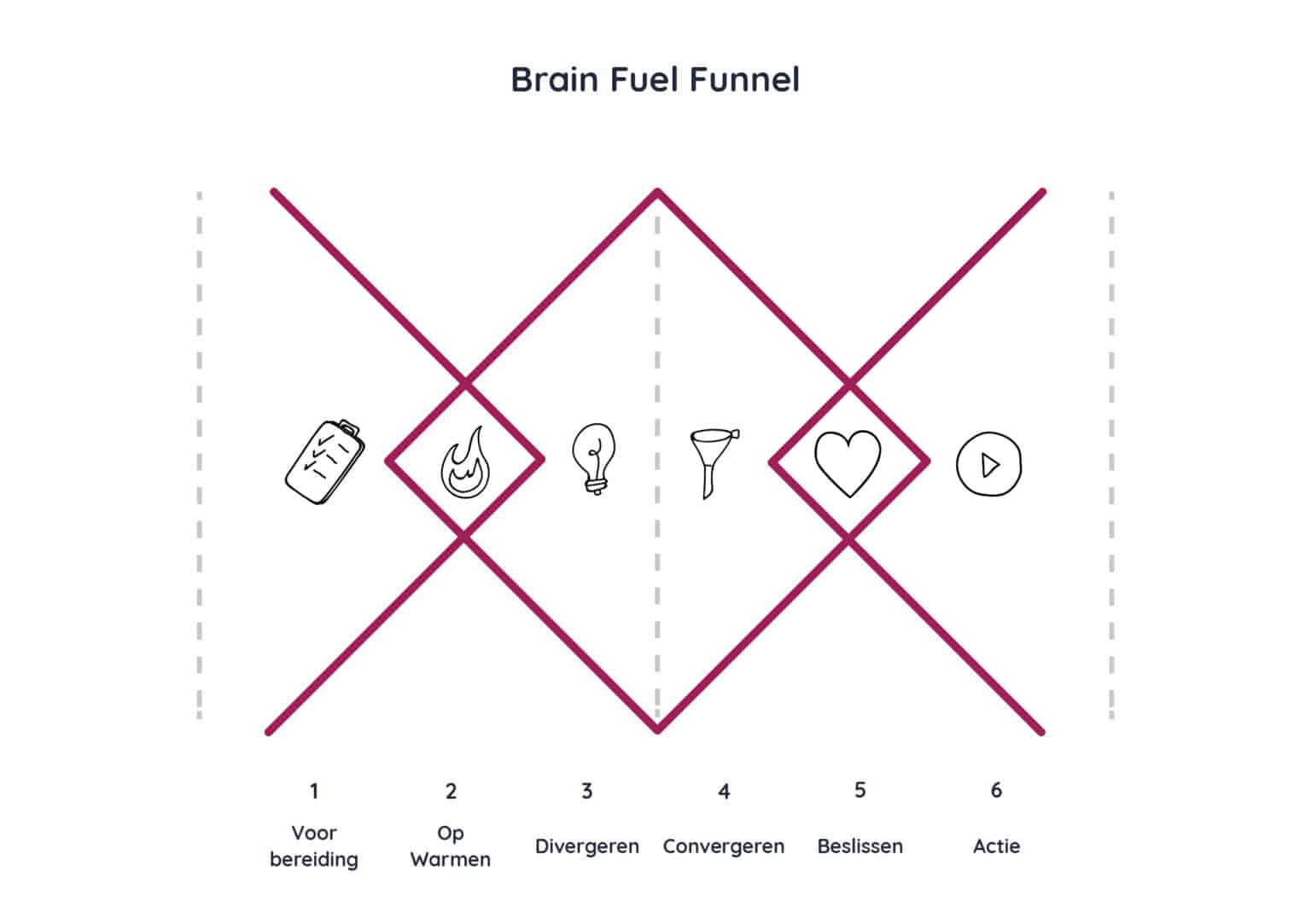Organize a brainstorm: the 6 stages for (great) succes

To facilitate a good brainstorm session is ridicously hard. Luckily: we’ve been doing this for years. Do you want to organize a brainstorm session? We have the six steps toward (great) succes for you.
In my business life I, Friso Visser, witnessed a lot of bad brainstorms. Who hasn’t, actually? These kinds of brainstorms are something I truly dread because I believe they are a waste of our time. It won’t make your company, life or the world a better place.
We really want to see a world where everyone can come up with great ideas. This is why we started Brain Fuel. A very important part in our way of work is our own method, the Brain Fuel Flow. This forms the ground of everything we do, and is a big part of how we build our sessions.
If you want to organize a really good brainstorm session, then you should definitely use the Brain Flow. In this article, I will explain how you can use it towards your own success. Completely free of charge. Buckle up!
Brain Fuel Flow: the six stages of a great brainstorm session
Before we start, these are the six stages of a great brainstorming session:
- Prep
- Warming up
- Divergence
- Convergence
- Decision
- Action
These always have to be there. Always.
In the next paragraphs we introduce you to each of these stages, and provide brainstorm methods and techniques when necessary.
Stage 1. Prep
The first blow is half the battle, right? I’ve noticed that many think they are ready to go when they have 1. a table and 2. stack of stickies. Well yeah, but no. Below you’ll find a list closer to reality.
But wait! First, you’ve got to ask yourself, your team and/or the problem owner if a brainstorm is the right way to reach your goal. It is? Keep reading!
1.1 A challenge
Make sure you start with a brainstorm question which gives both enough room and enough direction. simple maxim we use is to rewrite your question so that it begins with ‘How might we..‘ ‘How might we get more millennials in our customer base?’ or‘How might we stimulate diversity in our company?’.
You won’t get the right answers if you ask the wrong questions (except for the brainstorming technique in which you ask stupid questions to get creative results, but let’s talk about that at some other time).
1.2 A location
The location is probably the most neglected criteria of the brainstorm. Well, of course, there always is a location. But an appropriate location? Working in an environment that stimulates creativity ensures that people come up with creative solutions. A boring office with dropped ceiling means a higher chance of boring ideas. It really is that simple.
Things you want your location to have:
+ Natural light
+ Plants in the room
+ High ceiling
+ An inspiring setting
Remember that a festival setting might give you a higher chance of ideas related to spare time, ‘alcohol’ and ‘summer’. A business setting could net you a higher chance of ideas related to ‘entrepreneurship’, ‘businessmodels’ and ‘making money’.
1.3 An A-team
People can make or destroy your session. Negative Nancy’s will suck out all the energy of out the room. But participants who are a bit too enthusiastic can also ruin your session because the quiet geniuses won’t get time to shine. Sometimes inviting the CEO of the company is a bad idea too: people might be inclined to agree with the boss. Strongly consider hiring a professional facilitator, this is where you will need them the most (well, that and time management).
Who you want:
+ People with different skillsets (they tend to solve things differently)
+ People with a constructive mindset (critical thinking is valuable, but keep yourself in check until the divergence stage)
+ People who will like each other (if they can’t stand each other you don’t’ want them in one room)
1.4 Materials
The materials you need depend on the brainstorming techniques you will use. Which in turn depends on the challenge you’re trying to solve, the size of your team and the location.
Wij usually use our own Brain Fuel deck of association cardsbut some situations ask for different techniques. But of course, there are a couple of classics you’ll never go wrong with.
The classics:
- Sticky notes (there are bigger variants for bigger sessions or people with a large handwriting)
- Brown paper. This paper -when combined with special glue-is like a magical wall on which all paper will stick.
- Coloured markers Don’t use pens, because in bigger sessions you can’t read from far away.
- Boards. Preferably big ones on which you can write (and stick the brown paper on).
Meer weten over hoe je deze zaken helder krijgt in gesprek met je klant? Read:7 tricks to build the perfect brainstorming question.
Stage 2. Warming up
Many people believe that warming-up is a waste of time. On the contrary! Every pro athlete starts with a warming-up before they workout. If you want pro results, then you have to warm up your creative brain too! But there is another important reason for warming up: it gives your team energy.
2.1 Choose your warming up wisely
Some warm-ups are focussed on making people more competitive. Some warming ups are there for people to get to know each other. Some warming ups are there to get people more accustomed with the subject matter. Make sure you choose your warm-up accordingly.
Stage 3. Divergence
This is the part that people consider brainstorming. Ideation. Creative thinking.
During a brainstorm session, people tend to focus on this step but forget the rest. We see the divergence round as part of a bigger process. And most of the times we divide this stage in two subparts:
3.1 Round 1: the brain dump
The brain dump is used to clear your mind of all ideas that might be cluttering your mind.
Maybe you already think you know the solution. Write it down! Maybe you have some super realistic solutions in the top of your mind. Write them down! At the end of this round, you should have many ideas – but you’re not there yet!
3.2 Round 2: creative exercise
After the brain dump, we take it a step further with a more creative technique. Realistic ideas are great and all, but let’s try to get some creativity going on.
Just like when choosing a warming up, choose a method that fits best with your situation. There are methods suitable for students, businessmen, prototyping, animal lovers, people who love to draw, large groups, individuals, etc.
Yes, there are dozens of methods you can use, but here are some of our favorites. Some are classics and some of them we invented ourselves!
3.3 Are we done?
HIt happens a lot that people end their sessionhere.. They look at the clock. Then they look at the wall and they see lots of colored stickies on the wall. This looks totally creative, guys. A job well done.
NO, THAT IS NOT TRUE. DON’T STOP. CARRY ON. We’re halfway there.
Stage 4. Convergence
Let’s say that the divergence part went great and you generated 300 ideas. Next step is to separate the wheat from the chaff! Time to choose ideas! There are several ways to do this. A lot of the time, these methods fall into the categorie “we don’t have much time anymore, pick what you like the most”. The famous Dr. Love method is an example of this. However, there are methods which are effective and efficient.
4.1 Naming and framing
1. First, stick the ideas that work together well in a group.
2. Then, give this cluster of ideas a name. If all the ideas in a cluster happen to be about ‘turning millennials into ambassadors’, then your cluster could be named “millennial ambassadors”. That was easy!
4.2 COCD-Box
Another one I love is the classic COCD-Box in which a team distributes in #now, #wow, #how and #no ideas. It’s a tad more complicated than that, but it’s still super easy, it friendly forces your team to make decisions together and it gives you a great overview of all your work.
Stage 5. Decision
All right, you’ve made some clusters. Onto the final stage: decision! Which ideas will you implement? Which need to go back to the drawing board? Which darlings will be killed?
This stage is so short that it might not feel like a stage at all. But it is – it is that important!
5.1 Selection Day
For this stage, I prefer our Selection Day method, which uses stickers to let individuals ‘tag’ ideas that they think is best is a couple of categories:




In Selection Day you make room for the team to talk about their individual reasons for believing in specific ideas. It could be that everybody agrees, but some healthy discussion might arise too. That is perfectly fine. Better now than later.
Stage 6. Action
And last but certainly not least, the action stage. Time to turn those ideas into actions. This is were the biggest problems of brainstorming arise because this is where people realize there is work to be done. And some people get very evasive!
So make sure you don’t leave the session before you know what will happen with the ideas your team approved.
You’d like to know the following of each and every selected idea or cluster:
+ What will be the next step?
+ When will be the next step?
+ Who is responsible for the next step?
+ How do we stay informed about the next step?
CONGRATULATIONS. YOU HAVE ORGANIZED A REAL BRAINSTORM.
I really hope our Flow, which is really helpful for us and our custome, has brought you a lot further. Let’s stop with bad ideas, and work together for solutions that improve your life, work and the world.
Dit hebben we ook opgelost
Creatief, effectief en/of wereldverbeteratief: hierbij een greep uit de problemen die we hebben opgelost.







